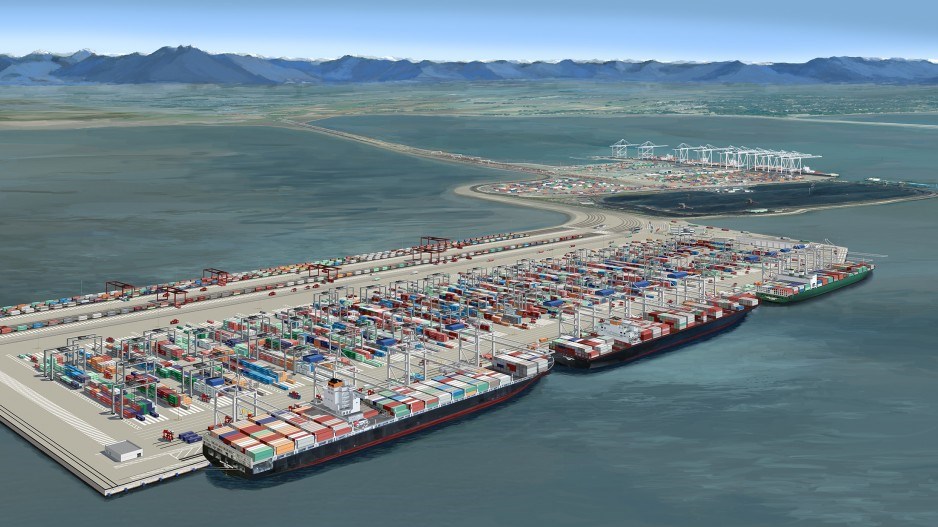Could plankton sink Terminal 2?
The Vancouver Fraser Port Authority’s $3.5 billion container cargo handling expansion project at Roberts Bank in Delta, B.C., won federal government approval April 20 after a decade-long odyssey through recalibrations, roundtables, retooling, community engagement and federal environmental regulations.
But it still needs provincial government approval, and, more daunting, its federal approval hinges on abiding by 370 legally binding conditions ranging from consultations with First Nations to investing in fish, mammal and wetland habitat protection.
Some of those conditions as outlined by federal Environment Minister Steven Guilbeault are more challenging than others.
But one could be more challenging than the rest. It could, in the eyes of some researchers, require the VFPA to send Terminal 2 back to the design drawing board or sink it entirely.
At issue is plankton, or, biofilm, as it is referred to in item 10.4 of Guilbeault’s 370 list.
And biofilm, researchers say, is at the base of the food chain pyramid for the Fraser estuary’s diverse avian and marine ecology.
Terminal 2’s impact on that biofilm is therefore important. According to the environment minister’s approval requirements, an independent scientific body will monitor the project’s impact and damage thresholds.
Item 10.4 gives the VFPA three options to mitigate any damage to the biofilm from Terminal 2’s construction and operation deemed unacceptable by the independent scientific panel: “biofilm habitat creation or enhancement … infrastructure redesign or removal.”
But as Simon Fraser University research associate Pat Baird has pointed out “no one has ever been able to establish good quality biofilm once it has been removed from an estuary or a bay.”
That is an important point that has been overlooked in Terminal 2’s approval, she told BIV. That would also leave the VFPA with options B (redesign) or C (removal).
“Everyone is looking at the wrong thing,” said Baird. “They’re looking at all these broad-brush things like number of birds, or whatever, but what you have to look at are these little diatoms.”
Those diatoms create biofilm. Or as Baird describes them: unicellular plankton, which, under specific environmental conditions, switches from creating carbohydrates to creating the Omega 3 fatty acids that are critical to the reproduction and growth of avian and fish populations.
So, according to Baird, what is Terminal 2’s main threat to their well-being and the well-being of what they do for the Fraser River estuary’s food chain?
In simple terms, the flow of Fraser River water into its estuary where it meets the Salish Sea during the spring creates the optimum conditions of water temperature, salinity and turbidity that trigger the diatoms’ switch from carbohydrate to Omega 3 production.
Baird said the Terminal 2 expansion project as designed would upset that natural chemical equation and, while the biofilm would not be eliminated, its quality would be inexorably altered.
And that, she said, would have devastating consequences for more than just the estuary’s Western sandpipers, because Omega 3s are critical for reproduction and growth for all animals.
The Terminal 2 project design involves doubling the size of the existing 85-hectare Roberts Bank container facility by landfill and adding an estimated 2.4 million 20-foot-equivalent to the Port of Vancouver’s container handling capacity. According to the VFPA, expanding Canada’s West Coast container capacity by approximately one-third is needed now to meet what it forecasts will be significant increases in transpacific cargo flow and demand over the next decade.
But Baird said Terminal 2’s design will interfere with the flow of the Fraser River into the Salish Sea.
She likened that interference to water coming through a faucet into a bathtub.
“And if you put a wall in front of that faucet, [then] it’s going to go around and around in a circle pretty much right on the other side of the wall, and [in the Fraser River’s case] the seawater is not going to be able to mix with it. So, you’regoing to segregate the seawater from the freshwater.”
That, she said, will affect the temperature, salinity and turbidity conditions needed to create biofilm.
Baird added that no amount of Terminal 2 construction contingency measures as currently designed will offset that impact.
According to Guilbeault’s requirements under item 10.4, the independent scientific panel will be required to monitor salinity changes caused by the project.
If baseline thresholds are exceeded during monitoring for at least 36 months after Terminal 2’s east basin containment dyke is built, the three mitigation options kick in: biofilm creation, infrastructure redesign or infrastructure removal.
But the VFPA’s Terminal 2 program director is confident that no major design changes will be needed to meet the conditions outlined in the environment minister’s list.
“We are confident in our detailed plans implemented prior to and during construction on how we will fully mitigate effects on biofilm and Western sandpipers,” Devan Fitch said in an email response.
He added that those plans “have been informed by more than 20 studies, an extensive field monitoring program and input from Indigenous groups, Indigenous knowledge holders, federal agencies and world-leading technical experts.”
Fitch said that condition 10.4, which includes the biofilm monitoring program that will be overseen by the independent scientific advisory body, was proposed by the VFPA “to offer certainty to regulators, the government and all Canadians that the project will be delivered in a way that protects and enhances the local environment.”
twitter.com/timothyrenshaw



